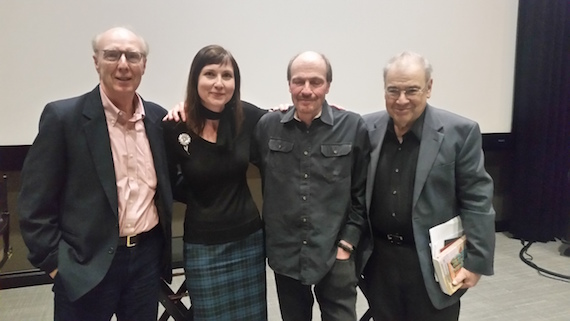

Pictured (L-R): Don Cusic, Brenda Colladay, Bobby Braddock, Michael Kosser
On Monday evening, April 18, Belmont University and the Metro Historical Commission held a special panel discussion titled A History of Music Row.
Metro Historic Commissioner Don Cusic emceed the event. Panelists included Brenda Colladay (former archivist and curator for the Grand Ole Opry Museum), Bobby Braddock (author of A Life on Music Row, and member of the Country Music Hall of Fame) and Michael Kosser, author of How Nashville Became Music City U.S.A.)
The discussion traced Music Row’s history, from Nashville’s founding to the early days of publishers including Tree Publishing and Acuff-Rose, through the Music Row area of today.
Some snippets from the conversation:
Songs and Gatekeepers:
“80 percent of the hit songs in the ’70s were solo writes,” said Braddock. “Now there are hits out there with six or more writers.”
“Publishing companies in the past few year have become the gateway to recording deals,” said Kosser. “Publishing companies are the artist development arm of the record companies, even if they are not related to particular ones. The record companies no longer pay a whole staff of A&R people. Taylor Swift’s recording deal began through what is now Sony Publishing. Kenny Chesney through Acuff-Rose…”
Where Have The Standards Gone?
“We used to have standards, songs that year after year remained popular, even after people forgot what the first recording of that sounded like,” said Kosser. “The way you made a standard, you had the hit come out and then dozens or hundreds of people [cut it]. … Bobby’s mentor is Curly Putman, and his biggest song was ‘Green Green Grass of Home.’ To my knowledge, it has had over 700 cuts. Today, I had a song cut by Josh Gracin years ago on his album, and I go into the publishing company three or four years later and say, ‘Hey, can we pitch this?’ They turn that down because it was out four years ago. It wasn’t a single, but no one wants to touch it because it was out there. This is just to give an idea of how things have changed. Is there such a thing as a standard today?”
The Grand Ole Opry, WSM, and Music Row:
“To get right down to it, the Opry and WSM radio are the entities responsible for Nashville being the center of country music,” said Colladay. “It’s mind boggling, all the side deals and family deals that happened back then. The first publishing company that published country music, the first booking agency that booked country stars out on the road, the first management company, it all came out of the Grand Ole Opry. Acuff-Rose was the first publishing company in Nashville. That was between Roy Acuff, who was the face of the Grand Ole Opry, and Fred Rose, a songwriter on staff at WSM for years. The first recording studio to record commercial music for major labels, was Castle Recording studios which started in 1946 by three radio engineers from WSM. They put it into the old Tulane Hotel and recorded [albums for] most major labels at the time. They recorded Hank Williams there. Jim Denny was at WSM and the Opry and he was one of the pioneers of Music Row. Owen Bradley was one of the staff band leaders for WSM radio. He of course started the Bradley’s recording studios and was the head of Decca Records. Chet Atkins was an Opry member, he became the head of RCA Nashville.”
“I was thinking about that memo that Jack Dewitt [founder of WSM] wrote in 1955,” said Cusic, “that caused people to leave the Opry and WSM, and forced them into building some businesses. At one point, WSM put their foot down and said they either work there or they do their own outside businesses. Jim Denny was running a publishing company, a booking agency. Recording studio engineers running their own separate businesses. So the head of WSM radio had them choose. The Castle engineers stayed with WSM because they were getting into television and everyone wanted to get into television at that time. Jim Denny however left and went on to great things, including Cedarwood Publishing.”
The Bradleys and The Quonset Hut
“According to Harold [Bradley], the studio was co-owned by Harold, Owen [Bradley], and Paul Cohen,” said Kosser. “Harold didn’t have much money at the time, and he was going to work there. Paul and Owen were going to put in the money. Owen cashed in his life insurance and put in the studio. They bought a kit from Sears I think and built a Quonset Hut behind the studio. That was what became Studio B of Columbia, and all that was recorded there was most of Patsy Cline’s hits, Johnny Cash… Eventually, Billy Sherrill cut all those songs that made Bobby Braddock rich on George Jones and Tammy Wynette and Tanya Tucker. Billy Sherrill dominated by cutting things in that studio, that old sheet-metal thing. They also did TV in there. A guy had a TV show in there and he had a barn set with wood, and it did so much good for the acoustics of the place that Harold and Owen asked the guy to leave the barn set, and that became an important part of the acoustics.
“One of the most important things to remember about Music Row in those days, is people flew by the seat of their pants. They weren’t afraid of anything,” said Kosser.

Category: Featured
About the Author
Jessica Nicholson serves as the Managing Editor for MusicRow magazine. Her previous music journalism experience includes work with Country Weekly magazine and Contemporary Christian Music (CCM) magazine. She holds a BBA degree in Music Business and Marketing from Belmont University. She welcomes your feedback at jnicholson@musicrow.com.View Author Profile


